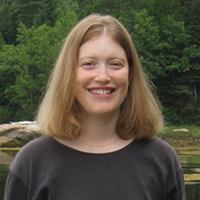Tanya L. Schneider
Hans and Ella McCollum ’21 Vahlteich Associate Professor of Chemistry
Chair of the Chemistry Department
Joined Connecticut College: 2010
Education
M.S., Ph.D., Yale University
Postdoctoral fellowship, Harvard Medical School
Antibiotic resistance
Quorum sensing
Tanya Schneider's research interests broadly include the biosynthesis and molecular recognition of natural products, with a current focus on antibiotics and bacterial quorum sensing molecules. Her undergraduate research group uses techniques from chemistry, molecular biology and biochemistry to consider new routes to mitigate the problem of antibiotic resistance.
Professor Schneider is the 2016 recipient of the Helen Mulvey Faculty Award for Fostering Student Achievement. The award was created in 2012 and is presented to a faculty member who excels at engaging students intellectually and teaching them to love learning. She is particularly interested in connecting biochemistry course content with current research whenever possible, and has developed lab projects for the course that allow students to ask new questions in the field of biosynthesis.
In 2011, Professor Schneider received a Cottrell College Science Award from Research Corporation for Science Advancement in support of her project titled 'Disarming bacteria through inhibition of the biosynthesis of quorum sensing signal molecules.' This grant provided funding for undergraduate summer researchers as well as equipment and supplies for the lab. Read more about this award.
Prior to her current appointment, Professor Schneider was a member of the Smith College faculty and spent several years working in the biotech industry. Her postdoctoral research at Harvard Medical School, funded by the American Cancer Society, probed the mechanisms by which bacteria produce epothilone, a promising new anti-cancer drug.
Selected publications:
*denotes Connecticut College undergraduate co-author
- E. G. Suneby,* L. R. Herndon & T. L. Schneider, 'Pseudomonas aeruginosa LasR·DNA binding is directly inhibited by quorum sensing antagonists,'ACS Infectious Diseases, 2017, 3, 183–189.
- P. Kafle*, A. N. Amoh*, J. M. Reaves*, E. G. Suneby*, K. A. Tutunjian*, R. L. Tyson* & T. L. Schneider, 'Molecular insights into the impact of oxidative stress on the quorum-sensing regulator protein LasR,' Journal of Biological Chemistry, 2016, 291, 11776-11786.
- E. A. Argueta*, A. N. Amoh*, P. Kafle* & T. L. Schneider, 'Unusual non-enzymatic flavin catalysis enhances understanding of flavoenzymes,' FEBS Letters, 2015, 589, 880-884.
- T. L. Schneider, K. T. Halloran, J. A. Hillner, R. R. Conry & B. R. Linton, 'Application of H/D exchange to hydrogen bonding in small molecules,' Chemistry - A European Journal, 2013, 19, 15101-15104.
- T. L. Schneider, 'Discovering chemical aromaticity using fragrant plants,'Journal of Chemical Education, 2010, 87, 793-795.
- T. L. Schneider & B. R. Linton, "Introduction to protein structure through genetic diseases," Journal of Chemical Education, 2008, 85, 662-665.
- T. L. Schneider, R. S. Mathew, K. P. Rice, K. Tamaki, J. L. Wood & A. Schepartz, 'Increasing the kinase specificity of K252a by protein surface recognition,'Organic Letters, 2005, 7, 1695-1698.
- T. L. Schneider, B. Shen & C. T. Walsh, 'Oxidase domains in epothilone and bleomycin biosynthesis: thiazoline to thiazole oxidation during chain elongation,'Biochemistry 2003, 42, 9722-9730.
Recent courses:
CHM 303 – Biochemistry I
CHM 304 – Biochemistry II
CHM 224 – Organic Chemistry II
She is a member of the American Chemical Society and the American Society for Biochemistry and Molecular Biology.
Visit the chemistry department website.
Contact Tanya L. Schneider
Mailing Address
Tanya L. Schneider
Connecticut College
Box # CHEMISTRY/Hale Laboratory
270 Mohegan Ave.
New London, CT 06320
Office
018 Hale Laboratory
